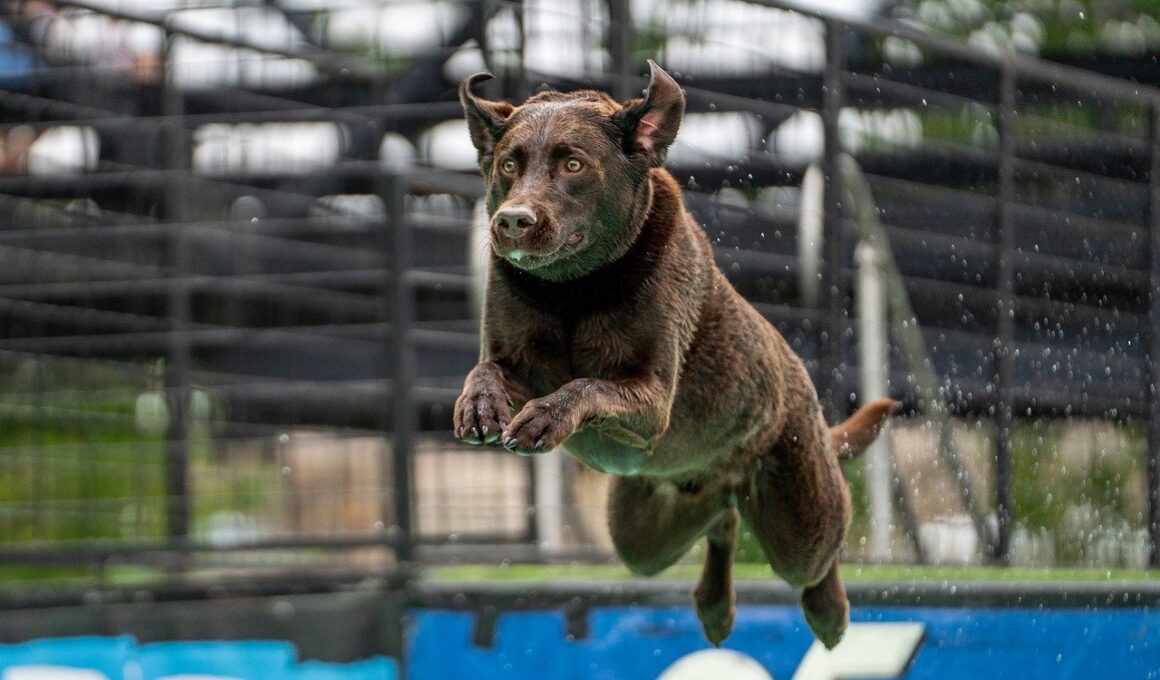Using Video Analysis to Improve Dog Sports Performance
Dog sports require significant coordination, skill, and training for optimal performance. As coaches and handlers strive to enhance their dogs’ abilities, video analysis emerges as a powerful tool. This technique allows for detailed observation of a dog’s movements and behaviors during practice sessions and competitions. The first step in applying this approach involves selecting a high-quality video recording device that captures multiple angles and perspectives. By analyzing these recordings, coaches can pinpoint specific areas for improvement. For instance, evaluating a dog’s start in agility can provide insights into pacing and acceleration. Additionally, reviewing the footage allows handlers to assess their own movements and communication with the dog, ensuring they are being as effective as possible. This mutual analysis fosters a better relationship between the handler and the dog. To maximize the benefits of video analysis, creating a structured plan is vital. Implementing regular video reviews after training sessions encourages continuous improvement. Furthermore, discussing these findings within a coaching community strengthens collaborative learning. The combination of passion, commitment, and innovative techniques like video analysis paves the path for success in dog sports.
The Benefits of Video Analysis in Dog Sports
Implementing video analysis in dog sports offers numerous benefits, primarily enhancing performance evaluation. By breaking down each component of a dog’s movement, both trainers and handlers can recognize patterns leading to success or failure. Analyzing video footage enables a deeper understanding of a dog’s technique, highlighting strengths and weaknesses specific to their athleticism. Detailed feedback, driven by visual evidence, often leads to more effective training sessions. Through visual learning, handlers and trainers can facilitate immediate corrections in training sessions. Visuals connect abstract concepts to practical application, ensuring that both trainer and dog are on the same page. Moreover, the ability to replay and pause footage fosters discussions about technique, strategy, and other critical elements. This analytical method also allows coaches to set measurable goals based on concrete performance data. Furthermore, sharing videos within coach-handled communities empowers others to offer perspective and advice. Notably, progress can be documented over time, showcasing improvements in the dog’s performance. As a result, both accountability and motivation are significantly increased. The use of video analysis ultimately transforms training into a more informed, efficient, and dynamic process.
Choosing the Right Equipment for Video Analysis
When it comes to using video analysis effectively in dog sports, selecting the proper equipment is crucial. The range of available technology can be overwhelming, but focusing on the essential features can streamline the process. First, invest in a high-definition camera that supports slow-motion playback and various angles, which can significantly enhance observation quality. The capability to zoom in on specific movements allows for a nuanced view of the dog’s performance, identifying precise areas for improvement. Additionally, consider mounting options, such as tripods or harnesses, to stabilize the camera during recordings. This stability is vital to achieve more accurate analyses without distraction. Furthermore, using a camera with good low-light performance ensures recordings during indoor training or evening events are still useful. Organizations may also invest in software that assists in editing and annotating videos. Annotation tools help mark critical moments in the footage, making it easier to revisit specific techniques during evaluations. By investing time and resources into finding the right equipment, coaches and handlers can ensure their video analysis is clear, precise, and ultimately beneficial for both the dog and their training efforts.
To maximize the effectiveness of video analysis in dog sports training, implementing a structured routine is essential. Regularly scheduled video sessions not only foster discipline but also create opportunities for ongoing feedback. After each training session, reviewing footage can spark insightful discussions about what worked and where improvements are needed. During these discussions, establishing clear goals becomes possible, providing direction for future training attempts. Coaches can set timelines to evaluate progress based on these specific goals. Moreover, utilizing annotations and comments within the videos can significantly enhance communication between trainers and handlers. This method provides visual reference points, ensuring that both parties are aligned in their understanding of the dog’s needs. Additionally, involving the dog in certain video review processes can be beneficial. Reactions to visual cues from past performances can help adjust training methods. By integrating reviews into a regular routine, both the coach and dog benefit from a consistent approach to refining techniques. Ultimately, maintaining a regular schedule for video analysis keeps both the trainer and the athlete engaged and focused on improvement.
Creating a Feedback Loop through Video Analysis
Establishing a feedback loop via video analysis can significantly enhance learning and performance in dog sports. This loop involves recording performances, providing feedback, implementing changes, and then filming again for further evaluation. Each phase of this loop plays a critical role in the overall development process. For instance, initial recordings capture a dog’s natural behavior and performance under competition-like conditions. Once these have been reviewed, trainers can offer specific and actionable feedback to the handler. The impact of thorough feedback cannot be overstated; it directly translates into more focused training. Implementing changes during practice based on this feedback creates a testing ground for techniques discussed earlier. Recording subsequent performances allows coaches to track improvements over time, reinforcing successful strategies. Additionally, refining feedback based on new footage creates a tailored approach specific to each dog’s learning style and capabilities. This adaptability is crucial, especially in dynamic sports environments. Ultimately, establishing this continuous feedback loop enhances understanding and capability for both the handler and dog. The synergy created by ongoing analysis and feedback contributes to long-term success in dog sports competitions.
As handlers and trainers engage in video analysis, it’s vital to maintain a positive mindset during reviews. While highlighting areas needing improvement is crucial, balancing this with recognition of accomplishments fosters a healthier training environment. Celebrating small wins documented in the footage can encourage handlers and dogs to remain motivated throughout their training journey. Furthermore, reframing perceived failures as learning opportunities can shift perspectives. Viewing challenges through a lens of growth rather than setback nurtures resilience and determination. Incorporating motivational strategies, such as setting attainable short-term goals based on video review findings, can maintain enthusiasm. For instance, focusing on improving a single technique at a time allows for incremental adjustments. Gradually building on successes can solidify a handler’s confidence, paving the way for more complex skills in the future. Establishing open dialogues between handlers and coaches around video analysis also creates a supportive atmosphere. This camaraderie significantly bolsters both learning and skill retention. Fostering a culture of encouragement during video reviews enhances both the dog’s performance and ensures the handler remains engaged and committed.
Integrating Technology for Enhanced Training
Incorporating additional technology during video analysis can greatly enhance dog sports training. Devices such as drones or multi-camera setups provide unique perspectives and insights not achievable with standard recording methods. Drones can capture aerial views of a dog’s agility course, offering a comprehensive view of how the dog navigates obstacles. Such perspectives can be instrumental in pinpointing issues with spacing, speed, and technique. Moreover, using apps designed explicitly for sports coaching can streamline the video analysis process. These applications usually contain features such as timers and instant replay functions that directly contribute to performance assessment. Integrating data analytics into video reviews can further enhance training by showcasing measurable statistics alongside visual evidence. For instance, tracking speed variations during different parts of a course can inform decisions about pacing strategies. Additionally, wearables, such as harnesses equipped with GPS, can provide real-time data on a dog’s movements. This combination of video footage and performance analytics creates a holistic approach to understanding the training process. By leveraging technology, coaches can provide a range of insights that aid in the development of specific strategies tailored to individual dog and handler teams.
In conclusion, employing video analysis in dog sports training is a multidimensional approach that enhances performance. It allows trainers and handlers to pinpoint specific areas for improvement and track progress over time. By utilizing high-quality video equipment, establishing feedback loops, and integrating supportive technology, the learning experience becomes more effective. Furthermore, fostering a positive environment during video reviews promotes resilience and motivation, ensuring enthusiasm continues to grow. Documenting both successes and areas that need work creates a well-rounded training paradigm. As both dogs and handlers embrace the feedback process, they foster a stronger bond, leading to improved performance. For individuals interested in enhancing their coaching methods, incorporating video analysis offers a promising path forward. Its application not only assists in achieving skill goals but also empowers trainers and handlers to enjoy the journey of growth alongside their canine athletes. Ultimately, the considerable advantages of video analysis in dog sports cannot be overstated. As the sport continues to evolve, those who adopt innovative strategies like this will remain at the forefront of achieving excellence.


